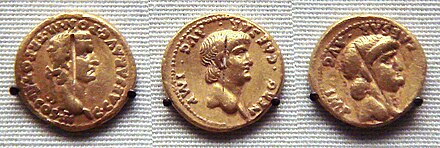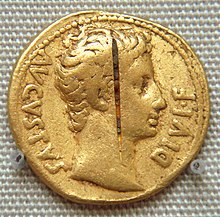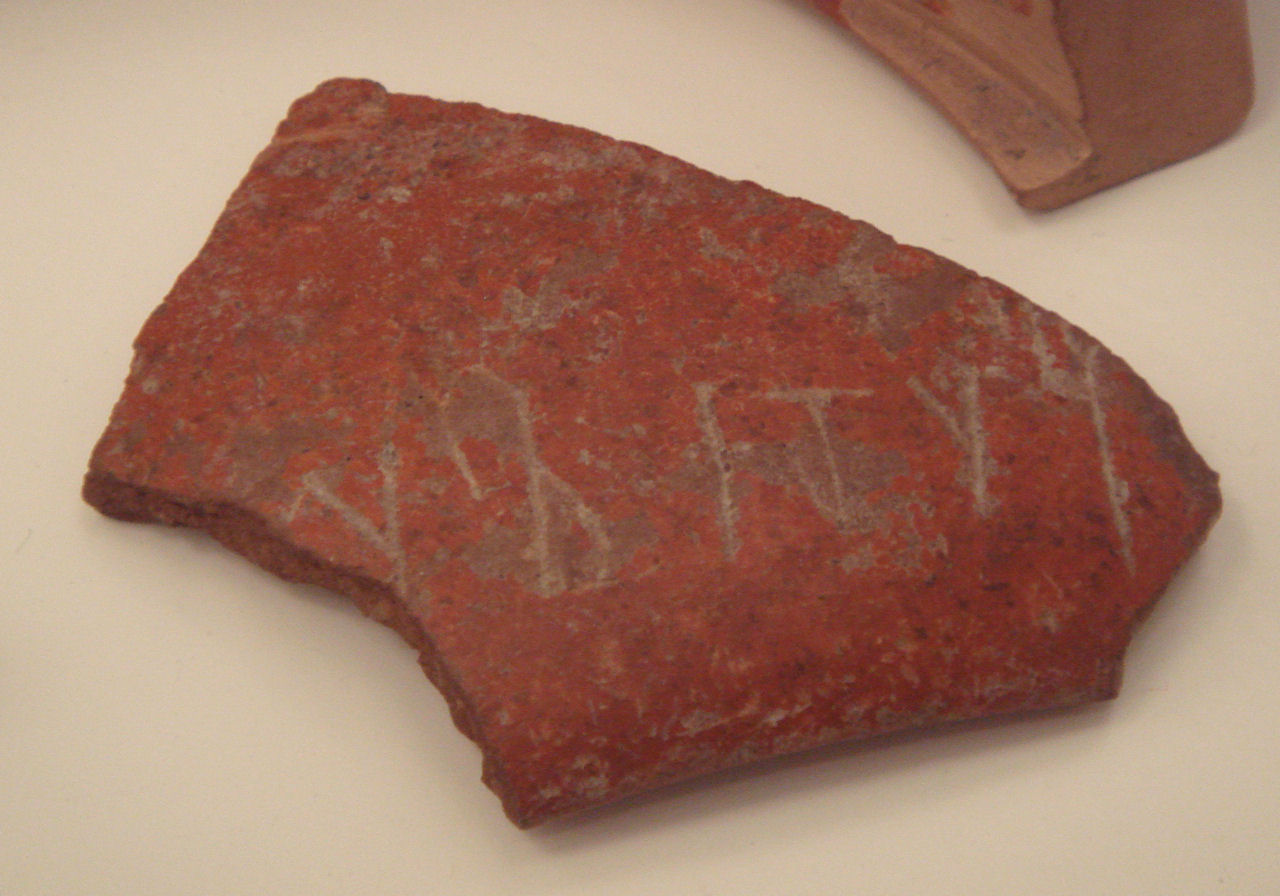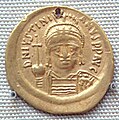

Coin of the Roman emperor Augustus[month of August is named after him] found at the Pudukottai hoard. British Museum.
-
Gold coin of Claudius (50-51 CE) excavated in South India.
-
Gold coin of Justinian I (527-565 CE) excavated in India probably in the south.
Roman-era cornelian stone reveals Arikamedu's rich naval history
PUDUCHERRY: French high school teacher G Jouveau-Dubreuil in Puducherry
did not realize that a small stone he received from a local boy in a
coastal hamlet in 1937 will make the world to turn its attention to the
Union territory of Puducherry.
A semiprecious stone (cornelian) with the face Roman emperor Augustus engraved on it found by the boy in the coastal hamlet not only fascinated the teacher but archeologists and historians worldwide in the subsequent years.
Dubreuil published his observations and findings of the stone and also fragments of Roman jars from Arikamedu, a coastal hamlet six km south of present-day Puducherry town, in a bulletin 'Les ruines Romaines de Pondichery' of Ecole Francaise d'Extreme-Orient, Hanoi XL in 1940.
The French teacher, who had written books on Pallava art and history of Deccan, concluded that Arikamedu was an erstwhile port, which flourished during ancient times (between 1BC and 1AD). He also declared that Arikamedu was referred as Poduke in ancient times.
His findings propelled the French government to undertake a rough excavation under the supervision of Brother Faucheux, the Foreign Missions Order and the then public works department head R Surleau.
They displayed the objects excavated at the government library without any detailed reference of the objects. Archeological Survey of India (ASI) director-general Mortimer Wheeler on learning about the findings undertook a massive excavation in 1945.
He proved that Arikamedu was a flourishing port with strong trade and commercial links with Roman Empire. Subsequent excavations by J M Casal between 1947 and 1950 and Vimala Begley in 1990s further proved that Arikamedu had trade links with Rome and other European countries.
The port town exported textile items, beads of semi-precious stones, bangles from shell and spices and imported Mediterranean wine, ceramic lamps, glass bowls, gems and olive oil among others.
"It (Arikamedu) is the only archaeological site that has cultural continuity from 300BC to 1800AD. It is regarded as a datum line for entire south India to date ancient artifacts excavated," said archaeologist and assistant professor (history), Tagore Arts College, Ravitchandirane Perumal, who organized a three-day workshop on 'Arikamedu artifacts for archeology and museology'.

Indo-Roman trade relations - Wikipedia, the free encyclopedia
A semiprecious stone (cornelian) with the face Roman emperor Augustus engraved on it found by the boy in the coastal hamlet not only fascinated the teacher but archeologists and historians worldwide in the subsequent years.
Dubreuil published his observations and findings of the stone and also fragments of Roman jars from Arikamedu, a coastal hamlet six km south of present-day Puducherry town, in a bulletin 'Les ruines Romaines de Pondichery' of Ecole Francaise d'Extreme-Orient, Hanoi XL in 1940.
The French teacher, who had written books on Pallava art and history of Deccan, concluded that Arikamedu was an erstwhile port, which flourished during ancient times (between 1BC and 1AD). He also declared that Arikamedu was referred as Poduke in ancient times.
His findings propelled the French government to undertake a rough excavation under the supervision of Brother Faucheux, the Foreign Missions Order and the then public works department head R Surleau.
They displayed the objects excavated at the government library without any detailed reference of the objects. Archeological Survey of India (ASI) director-general Mortimer Wheeler on learning about the findings undertook a massive excavation in 1945.
He proved that Arikamedu was a flourishing port with strong trade and commercial links with Roman Empire. Subsequent excavations by J M Casal between 1947 and 1950 and Vimala Begley in 1990s further proved that Arikamedu had trade links with Rome and other European countries.
The port town exported textile items, beads of semi-precious stones, bangles from shell and spices and imported Mediterranean wine, ceramic lamps, glass bowls, gems and olive oil among others.
"It (Arikamedu) is the only archaeological site that has cultural continuity from 300BC to 1800AD. It is regarded as a datum line for entire south India to date ancient artifacts excavated," said archaeologist and assistant professor (history), Tagore Arts College, Ravitchandirane Perumal, who organized a three-day workshop on 'Arikamedu artifacts for archeology and museology'.

Indo-Roman trade relations - Wikipedia, the free encyclopedia
en.wikipedia.org

Koyikkal Palace - Folklore & Numismatic Museum - lekshminivas ...
....................................................................................................................................
Koyikkal Palace - Folklore & Numismatic Museum - lekshminivas ...
sites.google.com
Museum
: Compare to the other Indian State the collection of the ancient coins
in the Kerala Archeological Department is very elaborate.
Roman trade with India
Roman trade with India started around the beginning of the Common Era following the reign of Augustus and his conquest of Egypt.[1] The use of monsoon winds, which enabled a voyage safer than a long and dangerous coastal voyage, helped enhance trade between India and Rome.[2] Roman trade diaspora stopped in Southern India, establishing trading settlements which remained long after the fall of the Roman empire[3] and Rome's loss of the Red Sea ports,[4] which had previously been used to secure trade with India by the Greco-Roman world since the time of the Ptolemaic dynasty.[5]Contents[hide] |
Background
The Seleucid and the Ptolemaic dynasties controlled trade networks to India before the establishment of Roman Egypt. ██ Kingdom of Ptolemy██ Kingdom of Seleucus
The Periplus Maris Erythraei mentions a time when sea trade between India and Egypt occurred through indirect sailings.[8] The cargo under those situations shipped to Aden.
Eudaimon Arabia was called fortunate, being once a city, when, because ships neither came from India to Egypt nor did those from Egypt dare to go further but only came as far as this place, it received the cargoes from both, just as Alexandria receives goods brought from outside and from Egypt.The Ptolemaic dynasty had developed trade with India using the Red Sea ports.
Establishment
The trade started by Eudoxus of Cyzicus in 130 B.C.E. kept increasing, and according to Strabo (II.5.12.):[12]
"At any rate, when Gallus was prefect of Egypt, I accompanied him and ascended the Nile as far as Syene and the frontiers of Ethiopia, and I learned that as many as one hundred and twenty vessels were sailing from Myos Hormos to India, whereas formerly, under the Ptolemies, only a very few ventured to undertake the voyage and to carry on traffic in Indian merchandise."By the time of Augustus up to 120 ships set sail every year from Myos Hormos to India.[13] Rome used so much gold for that trade, and apparently recycled by the Kushans for their own coinage, that Pliny (NH VI.101) complained about the drain of specie to India:[14]
"India, China and the Arabian peninsula take one hundred million sesterces from our empire per annum at a conservative estimate: that is what our luxuries and women cost us. For what percentage of these imports is intended for sacrifices to the gods or the spirits of the dead?" - Ibid., 12.41.84.
Ports
Roman Ports
Arsinoe, Berenice and Myos Hormos constituted the three main Roman ports involved with eastern trade. Arsinoe served as one of the early trading centers but Myos Hormos and Berenice, more easily accessible, soon overshadowed it.Arsinoe
The Ptolemaic dynasty exploited the strategic position of Alexandria to secure trade with India.[15] The course of trade with the east then seems to have been first through the harbor of Arsinoe, the present day Suez.[16] The goods from the East African trade landed at one of the three main Roman ports, Arsinoe, Berenice or Myos Hormos.[17] The Romans cleared out the canal from the Nile to harbor center of Arsinoe on the Red Sea, which had silted up.[18] That represented one of the many efforts the Roman administration had to undertake to divert as much of the trade to the maritime routes as possible.[19]The rising prominence of Myos Hermos eventually overshadowed Arsinoe.[20] The navigation to the northern ports, such as Arsinoe-Clysma, became difficult in comparison to Myos Hermos due to the northern winds in the Gulf of Suez.[21] Venturing to those northern ports presented additional difficulties such as shoals, reefs and treacherous currents.
Myos Hormos and Berenice
Myos Hormos and Berenice appear to have been important ancient trading ports, possibly used by the Pharaonic traders of ancient Egypt and the Ptolemaic dynasty before falling into Roman control.[22]The site of Berenice, since its discovery by Belzoni (1818), has been equated with the ruins near Ras Banas in Southern Egypt.[23] The precise location of Myos Hormos has been disputed with the latitude and longitude given in Ptolemy's Geography favoring Abu Sha'ar and the accounts given in classical literature and satellite images indicating a probable identification with Quesir el-Quadim at the end of a fortified road from Koptos on the Nile.[24] The Quesir el-Quadim site has further been associated with Myos Hormos following the excavations at el-Zerqa, halfway along the route, which have revealed ostraca leading to the conclusion that the port at the end of that road may have been Myos Hormos.[25]
Indian ports
In India, the ports of Barbaricum (modern Karachi), Barygaza, Muziris and Arikamedu on the southern tip of India acted as the main centers of that trade. The Periplus Maris Erythraei describes Greco-Roman merchants selling in Barbaricum "thin clothing, figured linens, topaz, coral, storax, frankincense, vessels of glass, silver and gold plate, and a little wine" in exchange for "costus, bdellium, lycium, nard, turquoise, lapis lazuli, Seric skins, cotton cloth, silk yarn, and indigo".[26] In Barygaza, they would buy wheat, rice, sesame oil, cotton and cloth.Barigaza
Trade with Barigaza, under the control of the Indo-Scythian Western Satrap Nahapana ("Nambanus"), especially flourished:[27]There are imported into this market-town (Barigaza), wine, Italian preferred, also Laodicean and Arabian; copper, tin, and lead; coral and topaz; thin clothing and inferior sorts of all kinds; bright-colored girdles a cubit wide; storax, sweet clover, flint glass, realgar, antimony, gold and silver coin, on which there is a profit when exchanged for the money of the country; and ointment, but not very costly and not much. And for the King there are brought into those places very costly vessels of silver, singing boys, beautiful maidens for the harem, fine wines, thin clothing of the finest weaves, and the choicest ointments. There are exported from these places spikenard, costus, bdellium, ivory, agate and carnelian, lycium, cotton cloth of all kinds, silk cloth, mallow cloth, yarn, long pepper and such other things as are brought here from the various market-towns. Those bound for this market-town from Egypt make the voyage favorably about the month of July, that is Epiphi. - Periplus of the Erythraean Sea, paragraph 49.
Muziris
Muziris represents a lost port city in the South Indian state of Kerala that had been a major center of trade with the Roman Empire.[28] Large hoards of coins and innumerable shards of amphorae found in the town of Pattanam have elicited recent archaeological interest in finding a probable location of this port city.According to the Periplus, numerous Greek seamen managed an intense trade with Muziris:[29]
"Muziris and Nelcynda, which are now of leading importance (…) Muziris, of the same kingdom, abounds in ships sent there with cargoes from Arabia, and by the Greeks; it is located on a river, distant from Tyndis by river and sea five hundred stadia, and up the river from the shore twenty stadia." - Paul Halsall. The Periplus of the Erythraean Sea, 53-54Pliny the Elder also matter-of-factly commented on the qualities of Muziris, although in unfavorable terms:[30]
"If the wind, called Hippalus, happens to be blowing, it is possible to arrive in forty days at the nearest market of India, called Muziris. This, however, is not a particularly desirable place to disembark, on account of the pirates which frequent its vicinity, where they occupy a place called Nitrias; nor, in fact, is it very rich in products. Besides, the road-stead for shipping is a considerable distance from the shore, and the cargoes have to be conveyed in boats, either for loading or discharging." - Pliny the Elder, Historia Naturae 6.26Settlers from the Rome continued to live in India long after the decline in bilateral trade.[3] Large hoards of Roman coins have been found throughout India, and especially in the busy maritime trading centers of the south.[3] The South Indian kings reissued Roman coinage in their own name after defacing the coins to signify their sovereignty.[19] The Tamil Sangam literature of India records mentions of the traders.[19] One such mention reads: "The beautifully built ships of the Yavanas came with gold and returned with pepper, and Muziris resounded with the noise."[19]
Arikamedu
The Periplus Maris Erythraei mentions a marketplace named Poduke (ch. 60), which G.W.B. Huntingford identified as possibly being Arikamedu (now part of Ariyankuppam), about two miles from the modern Pondicherry.[31] Huntingford further notes that Roman pottery had been found at Arikamedu in 1937, and archeological excavations between 1944 and 1949 showed that the city served as "a trading station to which goods of Roman manufacture were imported during the first half of the 1st century AD".[32]Cultural exchanges
Christian and Jewish settlers from the Rome continued to live in India long after the decline in bilateral trade.[36] Large hoards of Roman coins have been found throughout India, and especially in the busy maritime trading centers of the south. The South Indian kings reissued Roman coinage in their own name after defacing the coins to signify their sovereignty.[37] The Tamil Sangam literature of India recorded mention of the traders.[38] One such mention reads: "The beautifully built ships of the Yavanas came with gold and returned with pepper, and Muziris resounded with the noise."[39]
Decline
The decline in trade saw Southern India turn to Southeast Asia for international trade, where it influenced the native culture to a greater degree than the impressions made on Rome.[42]
The Ottoman Turks conquered Constantinople in the fifteenth century, marking the beginning of Turkish control over the most direct trade routes between Europe and Asia.[43]


No comments:
Post a Comment